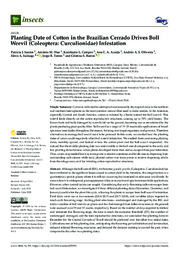Planting date of cotton in the Brazilian Cerrado drives boll weevil (coleoptera: curculionidae) infestation.
Planting date of cotton in the Brazilian Cerrado drives boll weevil (coleoptera: curculionidae) infestation.
Author(s): SANTOS, P. J.; DIAS, A. M.; CAMPOS, K. L.; ARAÚJO, A. C. A.; OLIVEIRA, A. A. S.; SUINAGA, F. A.; TORRES, J. B.; BASTOS, C. S.
Summary: Cotton is cultivated in subtropical and seasonally dry tropical areas in the northern and southern hemispheres as the most common natural fiber used to make textiles. In the Americas, especially Central and South America, cotton is infested by a beetle named the boll weevil. This weevil feeds directly on the cotton reproductive structures, causing up to 70% yield losses. The flower buds and bolls damaged by weevils fall on the ground, becoming lost or are retained by the plants producing poor-quality fiber. Boll weevil is a target of 19–25 insecticide applications of broadspectrum insecticides throughout the season, harming non-target organisms and growers. Therefore, alternatives to manage boll weevil need to be pursued. In this work, we studied how the planting dates of cotton could negatively affect boll weevil infestation. We studied three contrasting planting dates, monthly spaced, and looked at how the cotton plant and the boll weevil responded. We noticed that the middle-planting date was unfavorable to the boll weevil compared to the early and late-planting dates because cotton plants developed faster then and so escaped from pest infestation. Thus, cotton crop seeded late was more prone to receive numerous and fertile insects dispersing from surrounding cultivations while early planted cotton was more prone to receive dispersing adults from the refuge areas avid for infesting cotton reproductive structures.
Publication year: 2023
Types of publication: Journal article
Unit: Embrapa Vegetables
Keywords: Algodão, Anthonomus grandis grandis, Besouro, Bicudo, Cotton, Cultural control, Gossypium, Inseto
Observation
Some of Embrapa's publications are published as ePub files. To read them, use or download one of the following free software options to your computer or mobile device. Android: Google Play Books; IOS: iBooks; Windows and Linux: Calibre.
Access other publications
Access the Agricultural Research Database (BDPA) to consult Embrapa's full library collection and records.
Visit Embrapa Bookstore to purchase books and other publications sold by Embrapa.

